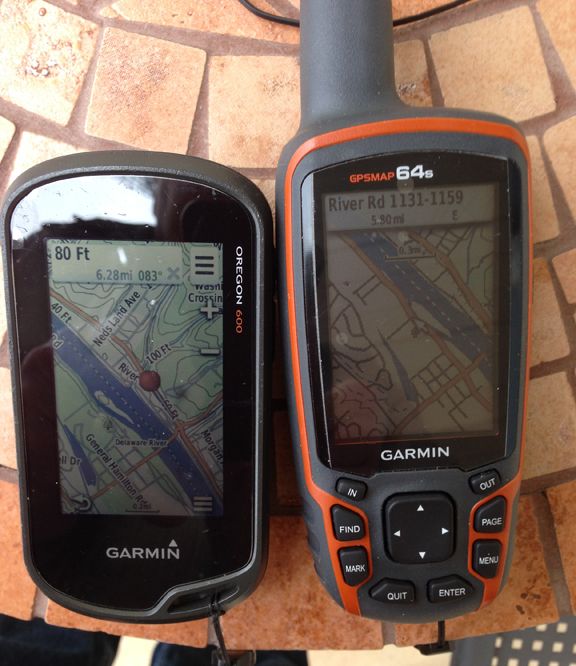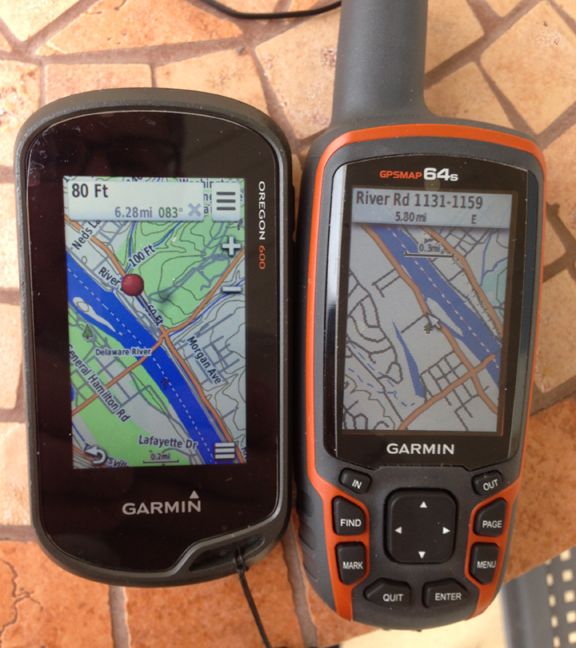|
|
Post by akerdoc on Apr 27, 2015 13:21:31 GMT -9
Has anyone used the new Garmin Oregon 650 or 600 with Glasnost support? How about the new Garmin 64? When I read about them online, some people seem to think the 64 with the antenna is more accurate than the Oregon. I have an old Oregon 450 for several years, but it seems like the 600 and 650 have a much better screen. I do like the touch screen. I got my father a Garmin 62 a couple of years ago, and I had some trouble getting used to using the rocker switch. However if it is more accurate, I would be willing to try to get used to it.
When I am caching with my Oregon and my iPhone, it seems like the iPhone is often more accurate than the Oregon for finding a cache. The iPhone doesn't seem to do as well for hiding one though.
Does anyone else have any thoughts on this? I am thinking about upgrading my handheld GPS. Any thoughts would be welcome.
Thanks
|
|
|
|
Post by SSO JOAT on Apr 28, 2015 7:03:25 GMT -9
I have a personal dislike of the touchscreens, however the technology is always improving and with people becoming dependent on the phone touch screens, they may find the touchscreen GPS to be acceptable. My review will be biaed toward the 62/64 primarily due to the touchscreen. The downside of touchscreens is their reduced durability and issues with using them in sub-freezing temperatures. I use my GPS across multiple applications, so it is just as likely to be mounted on my snowmachine or a boat or the dash of a vehicle. I trust my Garmins (all non-touch) to stand up to whatever I throw at them. They are completely waterproof and the screens are extremely durable. They've been swimming, covered with mud, frozen, dropped, dangling from a packstrap while stalking through willow thickets, and beaten to death on hard off road trails while mounted to the handlebar of ATVs and snowmachines. Going back to the early 1990's, I've never had a Garmin fail on me. My very first (GPS 40) is still sitting in a drawer full of antiques and it still works.
The operating systems are different, and I've not been very fond of the touchscreen interface (I'm sure it just takes some getting used to). The rocker keys on the 62/64 gives you a mouse pointer on the screen with very fine precision for selecting objects or scrolling to a particular location. That said, the thumb stick on the eTrex type units is a little more difficult, IMHO. The prcision of a touchscreen is a 1/2" diameter fingertip, translating to an area the size of a Walmart parking lot on the map screen. Picking a spot on a map is a trial and error process of sliding your finger and then lifting it up to see if you happen to be in the right spot, then trying it again.
The addition of the GLONASS signals is more of a novelty. Our own GPS constellation gives you great accuracy and if you are in a spot to get Differential corrections, you will regularly have sub 9-foot accuracy. My personal experience is opposite of yours in regard to phone vs GPS accuracy. I've found the phone to never display better than about 20-foot accuracy. Both devices require you to zoom in the map in order to see where the geocache is in relation to your current location. They will both find geocaches. You'll be better at finding caches with the device that you become the most comfortable with using, regardless of it's actual accuracy.
The GPS is far better for recording a location due to the built in waypoint averaging feature. You can set the GPS on top of the hide, start the averaging function, and take a break for a bit. Give the GPS a good 10-20 minutes of averaging time (minimum) and your published GC coordinates are going to be very solid. Leave (with GPS) and come back about 6 hours later and repeat the averaging function a second time and your coordinates will approach those of having a surveyor come out and mark your spot (OK, within a few feet instead of an inch, but it's still pretty dang accurate).
In the end, the external helix antenna on the 62/64 style GPS is better than the internal patch antenna used on the touchscreen devices. And note that the ext helix is designed to be used with the antenna pointing up (GPS vertical), while the patch antenna is designed to be used flat (screen horizontal). The typical user is holding the GPS at a ~45° angle, so either unit is splitting the difference of optimum antenna orientation. However, when I mount my 62 on a vehicle, it's going to be in a vertical orientation so I can view it while driving.
As for the 650/600, I have no exp with using these and cannot provide any specific feedback on them.
|
|
|
|
Post by akerdoc on Apr 29, 2015 11:49:23 GMT -9
Thank you for the great review.
As to my iPhone and Garmin 450 accuracy. I have found that when searching for a cache that my iPhone frequently gets me closer to the actual cache location than my Garmin 450. It also seems to get a fix much faster.
Thanks for the information.
|
|
|
|
Post by SSO JOAT on Apr 29, 2015 19:37:14 GMT -9
No problem. I will admit that I don't use the phone for caching very much. It may also be a factor of what you are using more often and/or more comfortable with. There are many different ways to get to the cache. As long as something is working; go with it.
|
|
|
|
Post by akerdoc on Apr 29, 2015 20:58:40 GMT -9
I think I am going to try the 64. This is an interesting post from the Groundspeak Forums In response to luvvinbird. If I had to rely on my 650 we wouldn't have found anything like as many caches as we have. Why? When compared to my wife's Garmin 62s it is inaccurate and sluggish. I would say that on 95% of our finds the 62s goes straight to the cache whilst the 650 is anything from 30 to 60 feet away. If you wait long enough the error will reduce but by that time my wife has signed the log and is on her way to the next. It is rare that I have a day's caching without having to remove the batteries because the unit has locked up. Screen sensitivity can also be a problem. I have programmed the user button to lock the screen as otherwise the very fact that it is banging against your body will cause it to do all sorts of odd things. Even with the screen locked it can suddenly re-configure itself, for example change or turn off a dashboard which may have happened to looneybin. If it is cold and you are wearing gloves you need to increase the sensitivity. However if it then starts to rain the screen is useless. Give Garmin their due, they have exchanged the unit twice free of charge but all three units have exhibited exactly the same faults. The 650 does of course have its good points. It is easy to scroll the map and enter data, for example next stage coordinates, and flip between applications, but if I had to have just one device for geocaching it would be the 62s. forums.groundspeak.com/GC/index.php?showtopic=331349 |
|
|
|
Post by akerdoc on Apr 29, 2015 21:25:16 GMT -9
Here are a couple of other posts about the 64 and the Oregon 6xx forums.groundspeak.com/GC/index.php?showtopic=328099&st=50I took the new 64s out today to locate and repair a couple of my own caches. Both were back in the woods and the 64s took me right to them. The Oregon tends to make me walk past the cache and then narrow things down and have make me walk back. This post has been edited by BikeBill: 19 December 2014 - 12:26 AM Posted 20 December 2014 - 11:06 AM Its really somewhat close as far as brightness outside. Below are two pictures of both GPSr's. It's a cloudy day but I had to get under the shade of the porch to cut down on glare. The light is coming from the left. The first picture is with the backlights off, the second with the backlights all the way up. Posted Image  Posted Image  The difference is even less when looking at the units in person as I couldn't get optimum viewing angle of both units at one time with the camera. But inside in low light, the 600 is definitely a bit brighter display with the backlight cranked up. Another difference is in the superior color of the Oregon 600. If you can zoom in, you may be able to see jaggies on the map lines of the 64s BUT it turns out I had different maps in the two units. I put the Garmin 24K Topo map in the 64s and the jaggies went away. On the other hand, the 64s pans and zooms faster than the 600. It also and seem to be more accurate and picks up more satellites (and hasn't crashed yet - but I haven't used it much). This post has been edited by BikeBill: 20 December 2014 - 03:14 PM |
|
|
|
Post by akgh519 on Apr 30, 2015 14:25:43 GMT -9
Thanks for the posts on this!
|
|
|
|
Post by TheFirefly on May 3, 2015 20:00:16 GMT -9
Thanks for all the info!! My current GPS is starting to fall apart, so I'm starting the search into something new...
|
|
|
|
Post by akerdoc on May 6, 2015 22:55:59 GMT -9
I just ordered the Garmin 64ST. I'll post what I think after it gets here.
|
|
|
|
Post by akgh519 on May 7, 2015 14:16:57 GMT -9
Good luck with it! Maybe you should try it out on the recently published 'Alaska State Star'!
It's nothing like Cuckoo Clock!!!
|
|











